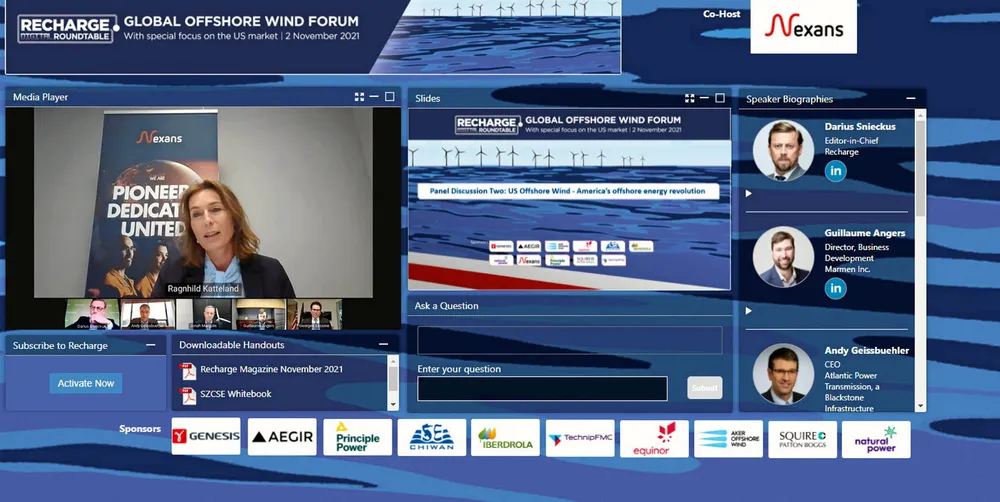'Work together to future-proof US offshore wind as play takes shape,' key exes urge
Recharge Roundtable told collaboration and innovation in technology, markets and policy crucial to rolling out today’s – and tomorrow’s – American supply chain

Yu Huang regional vice president Americas, for engineering consultancy Genesis, gave the roundtable an overview of the global and US offshore wind industries as she pinpointed innovation driven by collaboration as the key to success.
“In order for the industry to achieve its targets, we strongly believe collaboration among whole supply chains, through the asset owners, the developers, the technology institutes, consultants and advisors, is essential for the industry to continue to grow,” she told the panel. “Continued technology innovation is a must.”
Ragnhild Katteland executive vice president subsea and land systems at global cable giant Nexans, said: “The biggest challenge, and really the most exciting challenge is building the supply chain… because frankly speaking it's not there yet.”
“With early engagement and development of competencies and collaborating with stakeholders and partners, we are able to build that [supply chain],” Katteland said.
Complex collaborations bear fruit
While the alliance leverages the diverse manufacturing experience and capabilities of its various members, it also required a site partner as well as a partner in the development side, in this case Equinor-BP's Empire Wind, to create a market.
“It's four or five parties and a complex collaboration but at the end your industry can be built,” Angers said. “I can attest to the added value of collaboration.”
The fruits of that work will be “the most technologically advanced facility of its kind,” Angers added, with use of automation and robotics “to a point that has never been seen in this industry”.
Georges Sassine VP for large scale renewables at the New York State Energy Research and Development Authority (NYSERDA), told the panel that the need for collaboration extends beyond the industry itself and into the communities and authorities affected by development.
Sassine said: “I can't stress enough the importance of stakeholder engagement, whether it's at the local level, the state level, or the federal government and private sector citizens… you really need to hear everybody's voice and everybody's concerns, because if you're not really taking all these different perspectives into consideration, they are going to slow us down, down the line.”
Future proofing with latest technology
While many in the offshore wind industry fret about the dearth of port infrastructure and installation vessels, the lack of grid transmission capacity to absorb what will hopefully be 30GW of offshore wind power by 2030 is another monumental problem.
Andy Geissbuehler, CEO of Atlantic Power Transmission, which is helping plan links to US offshore wind projects, lauded New Jersey’s approach after the state agreed to pay for the network required to connect its eventual 7.5GW of wind power.
“New Jersey took a very bold step, and a very good step, to embark on planning transmission infrastructure,” he said.
Geissbuehler noted that deploying the latest technologies, including HVDC transmission lines is also crucial.
“With a horizon of 10 to 15 years, if you use up the very optimal locations for your landing site for the export cable [with older cables that carry less power], then you will have big problems [landing future projects],” he said. “You won’t get economies of scale using cables with a third of the capacity.”
Jonah Margulis, head of developer Aker Offshore Wind in California and a partner in floating wind pioneer Principle Power, said beyond collaboration and innovation there is one more crucial ingredient to supply chain success – demand.
“It's all about certainty,” he observed, noting that the fledgling floating wind sector is already being buoyed by a small but growing demand for components and skills sets.
“If you have certainty of demand of the market, you can see a supply chain forming,” Margulis said.